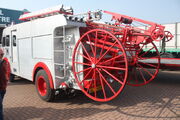
A Restored Bedford based Merryweather Fire engine
Merryweather & Sons of Clapham, later Greenwich, London, were builders of steam fire engines and steam tram engines.
The founder was Moses Merryweather (1791-1872) of Clapham, who was joined by his son Richard Moses (1839-1877).
Fire appliances[]
The Merryweathers worked with the engineer Edward Field to fit his design of a vertical boiler onto a horse drawn platform. They successfully applied it for use in their steam fire engine, thus improving water pressure and making easier to use once steam had been got up. It was reckoned that an engine could get up enough pressure to pump within ten minutes of a call out; the fire could be started before leaving the fire station so there would be enough pressure by the time they arrived at the scene of the fire.

A Merryweather "Fire Suds" unit on Roadless track units
Appliances were available in small sizes suitable for a country house, pumping about 100 gallons per minute, through to large dockyard models, rated at 2000 gallons per minute. A common size, popular with Borough fire brigades, was the double vertical boiler, that could pump between 250 and 450 gallons per minute. Merryweather also provided hydrants and mains water supplies for highly vulnerable sites such as theatres, where getting a strong enough supply of water could be a problem.
Dock fires were a particular problem, as the hand-operated appliances of the time had neither the reach nor the power to tackle a blaze on a boat or their large warehouses. After successfully demonstrating the improvement of the steam-powered powered devices fighting petroleum fires at Antwerp docks, Merryweather's appliances, with their distinctive crews wearing Merryweather helmets, soon became synonymous with firefighting in Britain and abroad,[1] alongside their rivals Shand Mason.
They also built specialist fireboats, such as a steam powered fire-fighting barge for the port of Alexandria,[2] designed to pump 1,200 gallons per minute to a height of 200 feet.
Tram engine production[]
Between 1875 and 1892 the factory produced about 174 steam tram engines, of which 41 were used in Britain, 46 in Paris, 6 in Kassel, Germany, 15 to Barcelona, 15 in the Netherlands, 11 in New Zealand and 15 in Rangoon.
Preservation[]
Preserved tram engine[]
In the Dutch Railway Museum at Utrecht is tram engine RSTM 2, built in 1881 (or 5?, built in 1882?)
Fire pumps[]
A number of Merryweather steam fire pumps are in preservation
Template:PML Merryweather steam FP
Fire Engines[]
A number of Merryweather fire appliances exist in UK museums and private collections.
References /Sources[]
- History of the Steam Tram by H. A. Whitcombe, published by the Oakwood Press in 1961
- A History of the British Steam Tram, Volume 1, by David Gladwin, Published at Sutherland in 2004: pages 78 – 86
- Tramway Lokomotiven by Walter Hefti, published by Birkhauser Verlag in 1980: pages 113 -116
External links[]
- Merryweather and Sons Official Website
- Steam fire engines
- Merryweather history
- Preserved tram engine
- Greenwich Industrial History Society Merryweather talk report, 3 June 2008
| ||||||||||||||||||||||||||||||||||||||||||||
| This page uses some content from Wikipedia. The original article was at Merryweather & Sons. The list of authors can be seen in the page history. As with Tractor & Construction Plant Wiki, the text of Wikipedia is available under the Creative Commons by Attribution License and/or GNU Free Documentation License. Please check page history for when the original article was copied to Wikia |